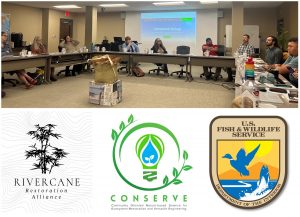
The story of rivercane is one of resilience, intertwined with the survival of both ecosystems and the Indigenous cultures that have depended on them. These once lush bamboo forests and grasslands that sustained the landscape, known as “canebrakes,” are now endangered. The rapid decline of this native bamboo species has had lasting consequences on the southeastern United States. Today, efforts like the Rivercane Restoration Alliance offer a chance to restore these environments and amplify the knowledge that sustains them.
Arundinaria gigantea is North America’s only native bamboo species native to watersheds across the southeastern U.S. While rivercane could once be found from Florida to New York, and as far west as Ohio over to Texas, rivercane now occupies just 2% of its former scope across the U.S. Typically found in sunny areas along banks of rivers and streams, dense clusters of canebrakes can grow to over 20 feet tall. The loss of these habitats threatens the survival of bird species that rely on them, such as the Swainson Warbler and the Louisiana Black Bear. Protecting these birds and other vulnerable species will take large-scale habitat conservation.
In the fall of 2024, the CONSERVE Research Group and Rivercane Restoration Alliance organized a workshop to discuss conservation efforts at the Alabama Water Institute in Tuscaloosa, Alabama. With funding and support from the U.S. Fish and Wildlife Service, the goal was to gain a greater understanding of native rivercane ecology with a special focus on its impact on birds. Framed around storytelling and sharing, the meeting aimed to collect multiple perspectives, especially from Indigenous communities. Attendees included Indigenous leaders from eight federally recognized tribes, with rivercane relationships dating back thousands of years. Additionally, avian specialists, rivercane conservationists, universities, government officials and non-profits were also present.
“This type of engagement with different communities, disciplines and interest groups is what conservation science efforts need moving forward,” said Michael Fedoroff, director of CONSERVE.
Rivercane provides many important benefits – cleaning water, filtering air, controlling erosion, stabilizing creeks and boosting soil quality. As an ecosystem, it offers even more: rivercane acts as a microclimate refuge, supporting favorable conditions that protect species during climate shifts, serves as a natural fire barrier to stop or slow the spread of wildfires and functions as a critical habitat for wildlife.
Though traditional ecologists may know less of this rare ecosystem, Indigenous knowledge is vast. Rivercane is essential for many Southeastern tribes and has been for thousands of years. One traditional use of rivercane is to weave Indigenous baskets. This process requires intensive knowledge of not only weaving but rivercane—with the basket weavers properly identifying the right time of year, accurate age class, appropriate stem diameter, stand health and harvest technique to gather the right rivercane for the basket. Basket weaving is still performed in many communities but has grown increasingly challenging as rivercane populations, particularly “old growth” large canebrakes, have diminished.
“The future ecology of native rivercane in the southeastern region can make improvements on a landscape scale if we continue to build alliances,” said Fedoroff. “The networks cultivated here at this CONSERVE workshop will sustain and increase the success of healthy lands and waters for future generations.”
Conservation of native rivercane forms a path towards resilience as it revives and renews ecosystems and cultural practices, weaving a unified terrain where nature and culture thrive. When we value rivercane not just as an ecosystem but as an enduring heritage, we pave the way for a more holistic and culturally informed conservation approach.
